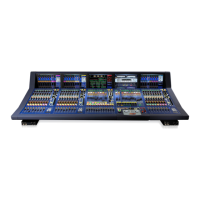161
XL8 Control Centre
Operator Manual
Chapter 9: Basic Operation
This chapter gives the basic operating procedures for the XL8 Control Centre. It
describes the controls and shows you how to navigate the control surface, and then
goes on to describe how to carry out basic operations. Service information on how
maintain the equipment and carry out routine servicing operations is provided at the
end of the chapter.
The chapter’s structure - based closely on the Quick Reference Guide
1
- has been
specifically formulated to give you a logical step-by-step introduction on how to operate
the XL8 Control Centre and how to get some audio out of it. For an in-depth guide on
XL8 Control Centre operation refer to Chapter 10 “Advanced Operation”. The more
advanced features of the XL8 are described in later chapters.
Please don’t forget that, although this system is a complex, high-tech piece of
equipment, it is very easy to use.
Control surface layout
During show time the screen functions that require fast access are controlled by control
knobs (rotary encoders), pushbutton switches, faders etc. More complex functions that
do not require this fast access are controlled by glide pad/trackball and navigation keys.
An integral keyboard pulls out from underneath the output bay to enable setting up,
configuration etc., on the output bay GUI screen. An external keyboard can be used on
any of the other bays, as each bay has a dedicated keyboard socket on the front of the
control centre.
The choice of controls provided by each bay type are prioritised by access time
importance. A fast zone area gives instant access to specific functions across the bay.
A channel strip to the right of the input and mix bays gives greater control of the
selected fast strip. Similarly, GUI screen displays are split into corresponding areas - a
fast zone on the left-hand side and a channel strip on the right - to make them easier to
follow.
Typically, the XL8 fast zone areas contain signal processing and routing levels for input
bays, but only routing level control on the mix and output bay channel panels. GUI
screen navigation tools (keys, glide pad, trackball etc.) are used to manipulate the
signal processing required for these paths. This distances these functions from the
mixing surface, thus allowing the operator to concentrate more on creative mixing. On
analogue systems this is the equivalent of the external processing racks. The exception
to this on the XL8 being the graphic EQ for monitor mixing, where fast access is once
again required; this is provided by the Klark Teknik HELIX RAPIDE DN9331 Graphic
Controller.
1. The XL8 Control Centre Quick Reference Guide (part number DOC04-XL8) provides a useful
introduction to the equipment and can be also be used for training purposes.

